Jibi Paul1, Syeda Khanam P2, Prachi Jain3, Abinaya.T4
Corresponding Author:
1Professor, Faculty of Physiotherapy, A.C.S. Medical College and Hospital Campus, DR. MGR. Educational and Research Institute, Deemed to be University, Chennai, India
Mail id: physiojibi@gmail.com
Co-Authors:
2Professor, East Point College of Physiotherapy, Bangalore, Karnataka, India
3AssistantProfessor, East Point College of Physiotherapy, Bangalore, Karnataka, India
4BPT Graduate, Faculty of Physiotherapy, A.C.S. Medical College and Hospital Campus, DR. MGR. Educational and Research Institute, Deemed to be University, Chennai, India
Abstract
| Background of the study: Poly cystic ovarian syndrome is the most common endocrine disorder in women of reproductive age, affecting 8 % – 12 % of women worldwide and is one of the most prevalent causes of infertility in women. The objective of the study is to compare the effect of aerobic training versus Plyometric training among young obese women with poly cystic ovarian syndrome. Methodology: The study was an experimental design, comparative and pre -post type. The study setting is at SKATER Reviving Touch Clinic, Chennai, with sample size of 20 subjects based on the inclusion and exclusion criteria. The study duration was about 12 weeks. The inclusion criteria were female subjects with age group between 21-30 years, menstrual abnormalities, previously diagnosed PCOS and Obese, BMI>25. Materials Used in the study were Treadmill (Walking), Elliptical trainers (Cycling), Skipping rope, Hurdle and Plyometric box. Outcome measure of the study was BMI, WHR and Regulation of menstrual cycle. Result: On comparing Pre-test and Post-test within Group A & Group B on BMI, WHR and PCOS questionnaire Score shows significant difference in Mean values at P ≤ 0.001. Conclusion: The present study concluded that the Aerobic training group was considerable to be more effective than Plyometric training group among young obese women with poly cystic ovarian syndrome. |
Keywords: Poly cystic ovarian syndrome; Aerobic training; Plyometric training; BMI;Waist-Hip Ratio
Received on 06th October 2021, Revised on 22nd November 2021, Accepted on 25th November 2021 DOI:10.36678/IJMAES.2021.V07I04.003
INTRODUCTION
Polycystic Ovarian Syndrome: Polycystic ovary condition (PCOS) is the most widely recognized endocrine problem in ladies of regenerative age, influencing 6%±10% of ladies worldwide1,6. Diagnostic models incorporate the presence of androgen overabundance, oligomenorrhea, and proof of polycystic ovaries (PCO) on ultrasound2,7. Though customarily saw as a conceptive issue, PCOS is currently arising as a deep rooted metabolic issue, with proof of expanded pervasiveness of corpulence, insulin obstruction, and metabolic syndrome3,11.However, the metabolic infection trouble in patients with PCOS surpasses that saw in straightforward obesity4,12.
Androgen abundance has been ensnared as an unmistakable danger factor, with a few examinations showing coursing androgen weight to connect intimately with proxy markers of metabolic danger, autonomous of weight list (BMI)5. About 50 % of ladies with PCOS are overweight or large characterized by Body Mass Index >25 or >30 kg/m 10.
Aerobic Exercise: High-impact practice is an actual exercise of low to extreme focus that relies essentially upon the high-impact energy producing process. “Vigorous” signifying “identifying with, including, or requiring free oxygen” and alludes to the utilization of oxygen to enough satisfy energy needs during exercise by means of high-impact metabolism8. Generally, light-to-direct force exercises that are adequately upheld by high-impact digestion can be performed for expanded timeframes. Vigorous limit alludes to the greatest measure of oxygen devoured by the body during extraordinary exercise, in a given time span. Aerobic exercise helps to burn calories, aids in vital control, rises serum HDL (High Density Lipoprotein) cholesterol, reduces weight and may improve IR. Aerobic exercises are: Walking, Cycling, skipping 9.
Plyometric Exercise: Plyometric is known as jump training. It is designed to enhance muscular power and explosiveness. In fact, it consists of fast and powerful movements. Plyometric exercises burn more calories in various ways. Infact, plyometric make the muscle bigger stronger and improve endurance capabilities, in thisway calories are burn at higher rate plyometric also enhance the metabolism which help in burning calories even when you do not perform any activity. Indeed, these exercises facilitate weight loss. Plyometric exercises are squat jumps, hurdle jumps, and jump boxes 17.
Walking: A treadmill is a gadget by and large for strolling or running or climbing while at the same time remaining in similar spot among the clients of treadmills today are clinical offices (clinics, restoration focuses, and clinical and physiotherapy centers, foundations of advanced education). Treadmills are presently basically engine driven. It has a running table with sliding plate18.
Cycling (Elliptical Trainer): It is a fixed exercise machine. Curved mentors are viewed as insignificant effect; they are an illustration of weight – bearing type of activity. Circular observed that use and oxygen utilization were something similar in the two types of gym equipment21.
Skipping: A jumping rope is a device, utilized where at least one member get around the rope swung so it passes under their feet and over the head. Avoiding 15-20 minutes is sufficient to consume off the calories. Numerous expert mentors, wellness specialists and expert contenders significantly suggest skipping for consuming fat over some other elective like running and running 22.
BMI: BMI is a very good indicator of whether you need to loss (or gain) body fat. Patients of PCOS often struggle with their weight. While there is no perfect BMI, those affected by PCOS should aim to keep their BMI between 20 and 25 23.
WHR: Waist outline in centimeters estimated at the tightest boundary, halfway between the upper line of iliac hull and the lower rib edge. Hip perimeter was taken as the most extensive estimation at the degree of more noteworthy trochanters24.
Questionnaire: The approved poll can be valuable for screening ladies with feminine inconsistencies, Hirsutism or other related finding for the presence of polycystic ovary disorder 14.
Aim of the study: Aim of the study is tocompare the effect of Aerobic training versus Plyometric training among young obese women with poly cystic ovarian syndrome.
Need of the Study: PCOS is one of the most common endocrine disorders in women during her reproductive years which may affect the regular menstrual cycles, BMI and WHR in women which may be increased in variably. Exercise programs which would help in losing the weight gained due to level of oestrogen in adipose tissue, lower insulin levels. There is a need of the study is designed to compare the effect of aerobic training versus plyometric training among young obese PCOS women
METHODOLOGY
The study was an experimental design, comparative and pre-post type. The study setting is at SKATER Reviving Touch Clinic with sample size of 20 subjects based on the inclusion and exclusion criteria. The study duration was about 12 weeks. The inclusion criteria are females, age group between 21 – 30 years, menstrual abnormalities, previously diagnosed PCOS and Obese, BMI > 25. The exclusion criteria are Hypertension, Cardiac conditions, ovarian tumour, Malignancy, Menstrual cyclic day and Normal women.
Materials Used: Treadmill (Walking), Elliptical trainers (Cycling), Skipping rope, Hurdle, Plyometric box
Outcome Measure: BMI, WHR, Regulation of menstrual cycle.
Procedure: 20 PCOS obese woman fulfilled with inclusion criteria will be randomly recruited in to two groups (group A & group B). Group A will be given aerobic training (Walking, Cycling, skipping) and Group B will be given Plyometric training (Squat jumps, Hurdle jumps, jump boxes) for a period of 12 weeks, 3 days per week duration is 45 minutes with 2 to 4 minutes rest between each workouts. And they will be evaluated before and after 12 weeks of the therapy through measuring their BMI and WHR.
Intervention: The study recruited 20 subjects with PCOS obese woman and the participants were questions for the presence of PCOS symptoms. Hence the subjects with PCOS in the age group of 21-30 years were selected on the inclusion criteria and exclusion criteria, they were fully explained about the study and asked to fill the questionnaire form in acceptance with participation of the study is signed by the participate and the research the subjects will be randomly recruited in to two groups (group A & group B). Group A will be given aerobic training (Walking, Cycling, skipping) and Group B will be given Plyometric training (Squat jumps, Hurdle jumps, jump boxes) for a period of 12 weeks, 3 days per week duration is 45 minutes with 2 to 4 minutes rest between each workouts. And they will be evaluated before and after 12 weeks of the therapy through measuring their BMI and WHR.
Aerobic Exercise: Walking (Treadmill), Cycling (Elliptical Trainer), Skipping
Plyometric Exercise: Hurdle jumps, Jump boxes, Squat jumps
Walking (Treadmill): Ask the patient to stroll on the treadmill for a time of 10-15 minutes. Screen the pulse, beat rate and the pace of breathing on the treadmill. The subject isn’t changing his even position and is latently moved and compelled to find the running belt under his feet. The subject can likewise be fixed in security saddles, underweighting frameworks, and different backings or even fixed in and moved with a mechanical orthotic framework using the treadmill.

Cycling (Elliptical Trainer): Ask the patient to ride the elliptical trainer for a period 10-15 minutes. Monitor the heart rate, pulse rate and the rate of breathing on the elliptical trainer.
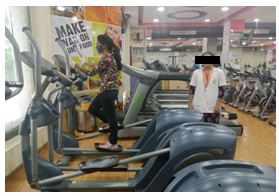
Skipping: Ask the patient to jump with both feet slightly apart over the rope for a period of 10 – 15 minutes. Monitor the heart rate, pulse rate and the rate of breathing on the skipping. The subject leap over a rope swung so it passes under their feet and over their heads. This high-impact exercise can accomplish a “consume rate” of up to 700 to north of 1200 calories each hour of vivacious movement, with around 0.1 to almost 1.1 calories burned-through per bounce principally relying on the speed and force of hops and leg collapsing.
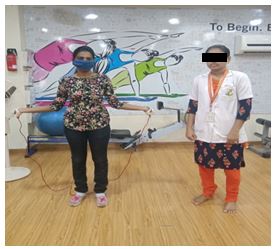
Hurdle Jump
Ask the patient to feet together, shoulder width apart and to take a small step towards the hurdle and leap over it for a period of 10-15 Minutes. Monitor the heart rate, pulse rate and the rate of breathing on the hurdle. Make sure the subject land on both feet and explore over the next hurdle.

Jump Boxes: Ask the patient to quarter-squat position and explosively jump up onto a plyometric box for a period of 10-15 minutes. Monitor the heart rate, pulse rate and the rate of breathing on the Plyometric box. The subject asked to engage the core to lift their legs as high as they can. Make sure the subject land on the surface in squat position, stand up straight.
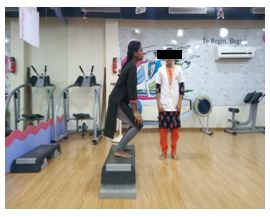
Squat Jump: Ask the patient to deep squat and jump as high as they can for a period of 10-15 minutes. Monitor the heart rate, pulse rate and the rate of breathing during the workout. Squat jumps are a powerful, plyometric exercise that increases the heart rate for a significant calorie burn. Before performing jump squats, the subjects should taught basic take-off and landing position to prevent injury.
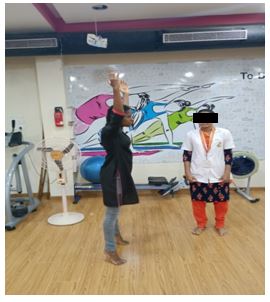
Data Analysis: The gathered information was organized and dissected utilizing both spellbinding and inferential insights. Every one of the boundaries was analyzed statistical package for social science (SPSS). Matched t-test was taken on to find the factual distinction inside the gatherings &Independent t-test (Student t-Test) was embraced to track down measurable contrast between the gatherings.
GROUP A- AEROBIC TRAINING

The above table 1 shows significant difference in BMI, WL, HL and WHR with P value <0.0001.
GROUP B -PLYOMETRIC TRAINING
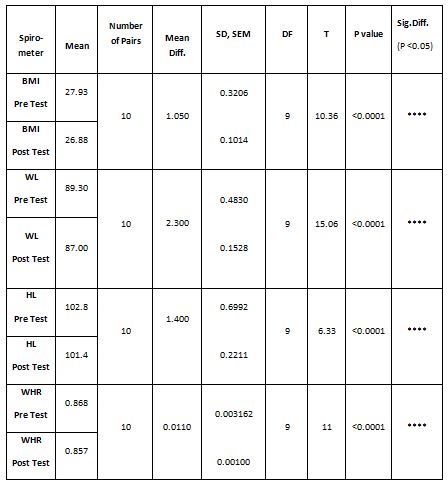
The above table 2 shows significant difference in BMI, WL, HL andWHR with P value <0.0001.
Comparative Study between Group A and B
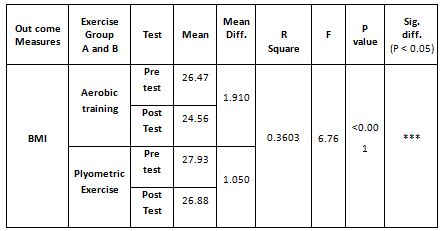
The above table 3 shows significant difference on BMI between Group A and B with P value <0.001, Aerobic training shows more effective with mean difference of 1.910.
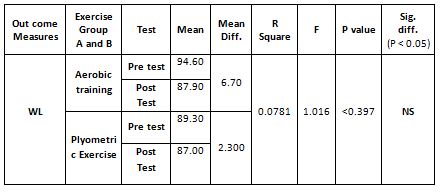
The above table 4 shows no significant difference on WL between Group A and B with P value <0.3968, but mean difference shows aerobic exercise more effective with mean difference of 6.70.
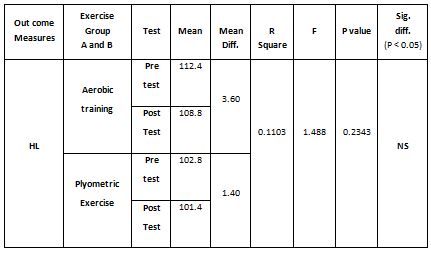
The above table 5 shows no significant difference on HL between Group A and B with P value <0.2343, but mean difference shows Aerobic training is more effective with mean difference of 3.60.
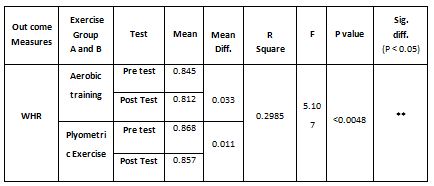
The above table 6 shows significant difference on WHR between Group A and B with P value <0.0048, Aerobic training shows more effective with mean difference of 0.033.
RESULT
Total 20 participants of young obese women with poly cystic ovarian syndrome were included in the study based on specific selection criteria with age group between 21 to 30 years.
In Group A, BMI, WL, HL and WHR has improved with mean difference of 1.910, 6.70, 3.600 and 0.033 respectively, by Aerobic training Exercise.
In Group B, BMI, WL, HL and WHR has improved with mean difference of 1.050, 2.300, 1.400 and 0.0110, respectively, by Plyometric Exercise.
Comparative study between Group A and Group B shows significant difference in BMI and WHR with P value >0.001 and <0.0048 respectively with more effective on aerobic training exercise. But HL and WHR shows no significant difference between Group A and B with P value <0.3968 and 0.2343 respectively.
Mean difference between Group A and Group B shows Aerobic training Exercise is more effective on BMI, WL, HL and WHR.
DISCUSSION
The aim of the study is to find out the comparative effect of aerobic training versus Plyometric training among young obese women with poly cystic ovarian syndrome.
20 subjects from SKATER reviving touch clinic, based on the inclusion criteria underwent aerobic training for group A and Plyometric training for group B for period of 12 weeks.
After 12 weeks, statistical analysis revealed that the Aerobic training group was considerable to be more effective than Plyometric training group among young obese women with poly cystic ovarian syndrome.
Most of the previous exercise studies in women with PCOS have only reported changes in BMI& WHR. In a non – randomized study found that the a three months structures aerobic exercise program improve BMI in overweight women with PCOS, compared to a non – aerobic exercise PCOS group 25,26.
The vigorous exercise works on the personal satisfaction in overweight PCOD ladies by lessening BMI, the quantity of follicles and the guideline of period 13.
The body weight, muscle versus fat substance, WHR, BMI and body lipid level of the two gatherings diminished essentially. The impact of high-impact preparing bunch was essentially better compared to the plyometric preparing bunch. The weight reduction and physical and emotional wellness state of the vigorous preparing bunch were superior to the Plyometric bunch16.
The 12 weeks of vigorous preparing with way of life the executives had enhancement for hormonal profile and personal satisfaction improvement among young ladies with PCOS 19, 20.
Reinforces is essential for embracing customary actual work in the treatment of metabolic and regenerative capacity in ladies with PCOS. Significantly standard exercise in ladies with PCOS has benefits in weight reduction with further developed administration of the metabolic and regenerative confusions17.
Metabolic aggravation like IR and weight are additionally connected with PCOS. It is thought to have hereditary etiology. The seriousness and course of the sickness are dictated by way of life, particularly BMI 15.
The comparison of post-test mean values of BMI and WHR over the subjects shows differences in the effectiveness to regular the periods, reduced BMI and decreased WHR, which explained that the symptoms decrease in post-test has lower mean value is more effective than the pre -test.
The result of this study shows that there is highly significant difference between post–test when compare to pre-test.
The result of this study also shows that there is a significantly reduced symptom of irregular periods, BMI 25, WHR by improvement in the functional ability following aerobic exercise in post-test values. The mean post -test scores aerobic training comparatively more than pre -test scores of aerobic training.
Ethical clearance: There was no risk of conducting this study.Ethical clearance was obtained from the ethical Institutional Review Board of Faculty of Physiotherapy, Dr. MGR. Educational and Research Institute, Chennai with reference No. A-02/PHYSIO/IRB/2019-2020 approval letter dated 07/01/2020.
Conflicts of Interest: There is no conflict of interest to conduct this study.
Fund for the study: This is self-funded study.
CONCLUSION
The present study concluded that there was significant improvement in 12 weeks of aerobic training had reduction of symptoms like to regular the menstrual cycle, decreased BMI & WHR and quality of life improvement in women with PCOS. Hence Aerobic training group was considerable to be more effective than Plyometric training group.
REFERENCES
- Harrison CL, Lombard CB, Moran LJ, Teede HJ, et al., Exercise therapy in polycystic ovary syndrome: A systemic review. Hum Reprod Update 2011;17:171-8
- Hischberg AL, et al., Polycystic ovary syndrome, obesity and reproductive implications. Womens Health (LondEngl) 2009; 5: 529-40.
- Speroffl MF, et al., Clinical gynecology endocrinology and infertility. 7th ed. Philadelphia: Lippincott Williamsans Williams 2005. p.465
- Hoeger KM, et al., Exercise therapy in Polycystic ovary syndrome. Semin Reprod Med 2008; 26:93-100.
- Febin Jebaraj A, Robert Alexandar C, et al., Effect of plyometric and aerobic exercise on obesity among school students. Sports and Health 2016; 3(2):83-85.
- Bozdag G, Mumusoglu S, Zengin D, Karabulut E, Yildiz BO, et al., The prevalence and phenotypic features of polycystic ovary syndrome: a systematic review and meta-analysis. Hum Reprod. 2016; 31(12):2841±55.
- Kumarendran B, O’Reilly MW, Manolopoulos KN, Toulis KA, Gokhale KM, Sitch AJ, et al., (2018) Polycystic ovary syndrome, androgen excess, and the risk of non alcoholic fatty liver disease in women: A longitudinal study based on a United Kingdom primary care database. PLoS Med 15(3): e1002542.
- Shetty D, Chandrasekaran B, Singh AW, Oliverraj J, et al., Exercise in polycystic ovarian syndrome: An evidence-based review. Saudi J Sports Med 2017; 17:123-8.
- VeenaKirthika S, Jibi Paul, Senthil Selvam P, SathyaPriya V et al., Effect of Aerobic exercise and life style intervention among young women with Polycystic Ovary Syndrome., Research J. Pharm. and Tech 2019; 12(9):4269-4273.
- Hoeger KM, et al., Exercise therapy in Polycystic ovary syndrome. Semin Reprod Med 2008;26:93-100.
- Wild RA, Carmina E, Diamanti-Kandarakis E, Dokras A, Escobar-Morreale HF, Futterweit W, et al., Assessment of cardiovascular risk and prevention of cardiovascular disease in women with the polycystic ovary syndrome: a consensus statement by the Androgen Excess and Polycystic Ovary Syndrome (AE-PCOS) Society. J Clin Endocrinol Metab. 2010; 95(5):2038-49.
- Fauser BC, Tarlatzis BC, Rebar RW, Legro RS, Balen AH, Lobo R, et al., Consensus on women’s health aspects of polycystic ovary syndrome (PCOS): the Amsterdam ESHRE/ASRM-Sponsored 3rd PCOS Consensus Workshop Group. Fertil Steril. 2012; 97(1):28-38 e25.
- Deepthi .G, Sankarakumaran .P, Albin Jerome, Deivendran Kalirathinam, NareshBaskar Raj, Mahadeva Rao US, et al., Effect of Aerobic Exercise in Improving the Quality of Life in Polycystic Ovarian Disease. Research J. Pharm. and Tech. 10(6): June 2017; 10(6): 1788-1790.
- Sue D. Pedersen, et al., Polycystic ovary syndrome -Validated questionnaire for use in diagnosis, Candian Family Physician 2007; 53:1041-1047.
- Abazar E, Taghian F, Mardanian F, Forozandeh D, et al., Effects of aerobic exercise on plasma lipoproteins in overweight and obese women with polycystic ovary syndrome. Adv Biomed Res 2015; 4:68.
- Guo Siqiang et al., Experimental study of aerobic exercise on the weight loss effect of obese female college students. Biomedical Research (2018) Volume 29, S193-S 196.
- Leanne M. Redman, Karen Elkind-Hirsch, Eric Ravussin, et al., Aerobic Exercise In Women With Polycystic Ovary Syndrome Improves Ovarian Morphology Independent Of Changes In Body Composition, Fertil Steril. 2011 June 30; 95(8): 2696-2699.
- Sao Paulo et al., Aerobic training in obese adolescents: A multidisplinary approach, July/Aug.2018: 24(4).
- Namrata N. Patel et al., Plyometric training: A Review Article, August 2014:6(15); 33-37.
- AfifiL, Saeed L, Pasch LA, Huddleston HG, Cedars M I, Zane LT, Shinkai K et al., Association of ethnicity, Fitzpatrick skin type, and hirsutism: A retrospective cross – sectional study of women with polycystic ovarion syndrome, international journal of women’s dermatology, march 2017; 3(1);37-43.
- Cronin L, Guyatt G, Griffith L, Wong E, Azziz R, Futterweit W, Cook D, Dunaif A et al., Development Of A Health – Related Quality Questionnaire (PCOSQ) For Women With Polycystic Ovary Syndrome (PCOS), The Journal Of Clinical Endocrinology & Metabolism, 1June 1998; 83(6); 1976-1987.
- HarbansLalGodara, ChitraBishnoi et al., Effect Of Aerobic Training On Percentage Of Body Fat, Total Cholesterol And HDL – C Among Obese Children,IOSR Journal of Sports and Physical Education (IOSR – JSPE); Nov-Dec 2013;1(2).
- MortezaTaghavi, Mohammad Ali Sardar, FahimehAyyaz, Hale Rokni et al., Effect Of Aerobic Training Program On Obesity And Insulin Resistance In Young Women With Polycystic Ovary Syndrome, Iranian journal of diabetes and obesity, 2011; 3(1).
- Khademi A, Alleyassin A, Aghahosseini M, Tabatabaeefar L, Amini M, et al., The Effect of Exercise in PCOS Women Who Exercise Regularly, Asian J Sports Med; 1(1):34874.
- Susan Sam, MD, et al., Obesity and Polycystic Ovary Syndrome, 2007 April; 3(2): 69–73.
- Francesco Giallauria, ET AL., Relationship between heart rate recovery and inflammatory markers in patients with polycystic ovary syndrome: a cross-sectional study, Journal of Ovarian Research, (2009 Feb 2; 2:3. doi: 10.1186/ 1757-2215-2-3.
Citation: Jibi Paul, Syeda Khanam P, Prachi Jain, Abinaya.T(2021). Comparative effect of aerobic training versus plyometric training among young obese women with poly cystic ovarian syndrome , ijmaes; 7(4); 1135-1147.


Leave a Reply